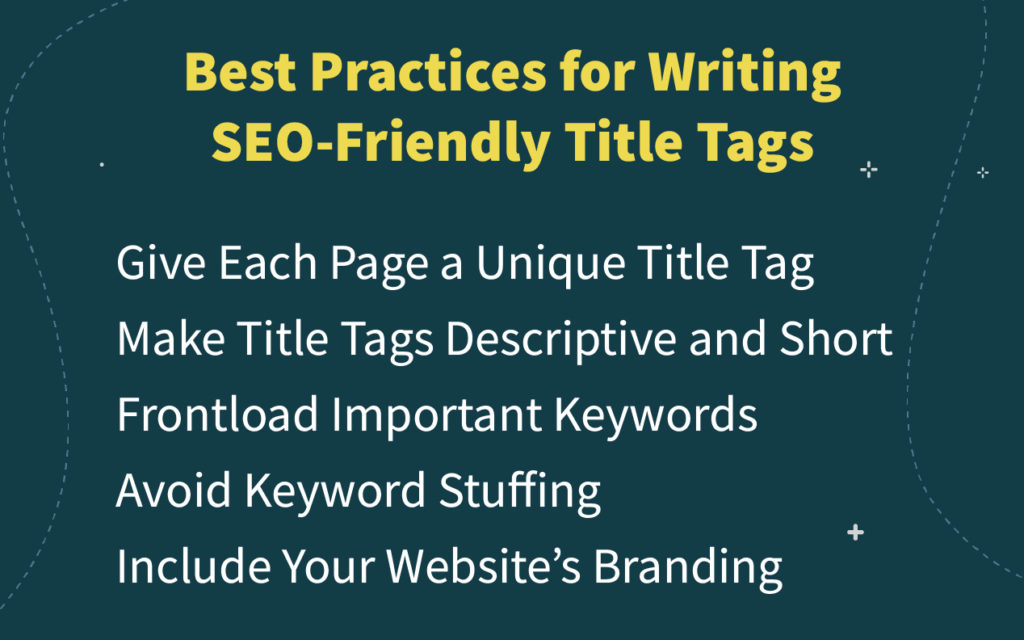Your title tag is often the first thing that users will see when they do a search on Google.
An SEO title tag is the title of your web page and the first visible element users interact with when they come across your website. It’s an indication that your website is available and ready for users to visit and interact with. In a way, it’s the brick-and-mortar equivalent of a retail store putting up a sign by the entrance that reads “we are open.”
They aren’t just for users either. Your SEO page title is one of the first elements that search engines scan when they crawl your website, and it’s one of the main ways they determine the topic and purpose of your web page. That makes it a small but very important part of your website’s keyword rankings and SEO performance.
In this post, we’ll cover what a title tag is and what it’s for, advise on best practices for writing SEO title tags along with examples, and walk through how to find and fix title tags when they’re missing or broken.
What is a Title Tag?
A title tag is an HTML element that expresses the title of a web page. It helps both users and search engines to understand the topic of the web page and what the content is about. It’s located in the section of your web page’s HTML document
Just by looking at the title tag, a user or a search engine can determine whether the page is a how-to blog post, a product page on an ecommerce store, or the homepage of a website.
Your title tag is the text that’s displayed in the SERPs and is the first thing a user sees when they find your website on Google.
The SEO page title SEO is also displayed on your web browser window. When you have multiple tabs open, it helps you recognize which tab is which.
Essentially, the title tag is your web page’s headline. Your SEO title is meant to tell users and search engines what to expect when they visit your web page.
Why Title Tags are Important for SEO
Website title tags are important because they help both users and search engines understand what the web page is about.
Essentially, title tags are your website’s real estate on search engine results pages. Website visitors use your title tag to choose your website among the other results that rank for whatever their query is. It helps them determine whether your web page is the most appropriate, useful, or relevant result for what they’re looking for.
Title tags aren’t just important from a user experience standpoint either. They are also a small but important part of your website’s ranking, along with other HTML elements like h1 tags and meta descriptions. Search engines use keywords in your title as a ranking factor when determining your web page’s relevance for a query.
Your SEO page title also has an impact on user metrics like click-through rate (CTR). Your title tag CTR and other user metrics affect your SERP rankings for non-keyword-related reasons. Ultimately, the purpose of your page’s title tag is to give your users a reason to click on it and visit your web page. If your SEO title has a higher CTR than competing pages ranking for the same query, it indicates to search engines that your page is the most relevant one.
It doesn’t take a lot of effort to write keyword-optimized and well-written title tags. In this way, title tag optimization can be considered low-hanging fruit. Title tags that have relevant long-tail keywords and language that uses good persuasive copywriting principles play a real role in driving traffic and leads to your website.
Best Practices for Writing SEO-Friendly Title Tags

It’s important to remember that you don’t directly control how your title tag is displayed on the SERPs. Google and other search engines decide what title to give your web page based on a number of factors. The best you can do as a website owner is influence those factors and use best practices for writing title tags.
Google offers some guidelines on how website owners can influence their title tags.
A title tag should include the purpose of the page, a relevant keyword, and your website’s brand in no more than 60 characters. Common naming conventions for title tags that websites often use are:
Primary keyword | BrandPrimary keyword | Secondary keyword | BrandA sentence using target keywords | BrandPrimary keyword (and secondary keyword)
Give Each Page a Unique Title Tag
Each page on your website should have a unique title that identifies it among the other pages on your website. Indicating your title using the HTML element tells search engines what you consider to be the page’s title.
Having multiple pages with the same title can create duplicate content issues and confuse users trying to find a specific page on your website, particularly if you have multiple pages ranking on the SERPs for the same keyword.
This becomes harder to do the more web pages you have, particularly if you have 100’s or 1000’s of pages with similar content. Ecommerce stores that have product pages that have color or size variations of the same item encounter this problem frequently. A solution to this problem is to dynamically update your title tag based on the content on your page.
Make Title Tags Descriptive and Short
Your title should tell users and search engines what’s on the page in as few words as possible. Google tends to truncate title tags that are longer than 55-60 characters in length. Avoid any vague language like “home” or “account”, or any overly long sentences. Your title should be an accurate representation of what users will find on the page.
Frontload Important Keywords
Putting top-of-funnel keywords as close to the beginning of the title tag as possible improves your search rankings. Most users will scan the first few words of the title tag before they decide whether or not the page is worth clicking on. As such, strategically placing top-of-funnel keywords in your title tag can help boost traffic as well as your CTR.
Avoid Keyword Stuffing
Your title tags should be optimized for your user, not for search engines. Although its helpful to include one or two keywords in your title if they’re relevant to the web page, forcing multiple keyword variations into the title turns them into incomprehensible gobbledygook and is a red flag to Google’s algorithm. Only include keywords in your SEO page title if they apply to the content on the web page.
Include Your Website’s Branding
Along with keywords, your title tag is also an opportunity to build brand awareness if you include the name of your brand in your title. Google recommends putting your brand name at the beginning or the end of your title and separating it from the other text using a colon (:), hyphen (-), or a pipe (|). An example of this might look like:
25 Most Common Technical SEO Issues | Prerender
How to Find and Fix Missing, Duplicate or Truncated Title Tags</h2><p>The best tool you can use to find on-page SEO title tags that are too long or altogether missing is Screaming Frog. The free version of Screaming Frog lets you crawl up to 500 URLs for free.
Screaming frog lets you view your website’s title tags in various places in its navigation, and checks for title tags with over 60 characters or page title tags that are missing.
To find the missing over under-optimized tile tags:
- Let Screaming Frog finish crawling your website
- Go to the “Page Titles” tab
- Filter by “Over 60 Characters,” or “Duplicate”
Screaming Frog can also show you your title tags in the “Overview” tab on the right-hand side. Or, you can use one of a number of Screaming Frog Alternatives like:
Some free alternatives you can use to find your title tags are:
Wrapping Up
In online business as elsewhere, first impressions matter.
Your title tag is the first thing that your visitors will see when your website shows up on Google, and it should give your users a reason to visit your website.Put your website right where the most people will see it, and register with Prerender for free today.



